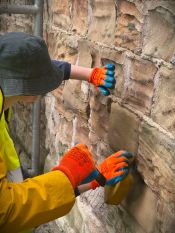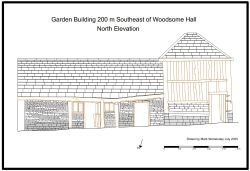The Cathedral Church of Saint Nicolo presents a fine Baroque façade
The Cathedral Church of Saint Nicolo presents a fine Baroque façade, designed by Architect Francesco Sinatra. Looking at it now we can almost forget the major collapse of the church in 1996 and the subsequent reconstruction of the Nave and Dome.
Like other Noto buildings the cathedral S. Nicolo is entirely stone, without a single brick. Some were quarried from the site of the city and others are brought from quarries nearby. They include various grades of sandstone and limestone. However a large section of the Nave collapsed in 1996. Why was this?
The construction techniques used for the Cathedral after it was rebuilt following the earthquake of 1693 are similar to those described by Giovanni Biagio Amico (1684-1754) in his treatise L'Architetto Prattico (1726/1750). Amico writes that among the various kinds of walls is a way of making encased walls, in which the exterior is constructed of squared stones and linked together with other squared stones keyed are right angles, and filled with stones and earth, or mortar. In Sicily they use mostly uncut and roughly cut stone, filling the remaining voids with small stones and mortar with finely hammered lime. This stone masonry technique, described by Vitruvius, was well known in Antiquity.
The ultimate stability of the mass of stones depends upon the strength of the lime mortar and if all else fails on the ashlar masonry skin of the wall. In the last campaign to finish the early 18th century nave of S. Nicolo stonemasons made a major miscalculation in the construction of the nave piers which nullified any attempt to make the building safe in future earthquakes.
The static loads of the clerestory, side vaults, nave vaults, and dome are were all carried by the nave piers but they were the weakest part of the entire building. Because of one mistake, the use of round river stones in their construction. They should have been broken up if used in walls. After the Calabrian earthquakes of 1783 authorities condemned the use of round river stones in walls as being one of the causes or building failures in earthquakes. The mistake of using round river stones in the piers was compounded by the use of poor rubble limestone and weak mortar and an even weaker external ashlar revetment.


Related Articles

The steps members of the Waterton’s Wall restoration team, with support from Mark Womersley, have been following to consolidate, conserve and repair this historic wall that represents the successful efforts of Charles Waterton to preserve the wildlife that lived on his estate near Wakefield in West Yorkshire.
1. Fill deep voids behind the wall’s facing stones with deep pointing work. The works involve …

Mark spent a day recording a historic timber-framed garden building at Woodsome Hall
Mark Womersley, as part of his voluntary work with the Yorkshire Vernacular Buildings Study Group, spent…

M Womersleys were delighted to offer a day of tutoring to those who attended the Wentworth Woodhouse Working Party
M Womersleys were delighted to offer a day of tutoring to those who attended the Wentworth Woodhouse…